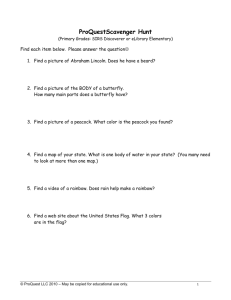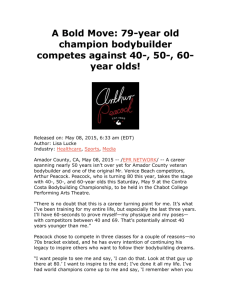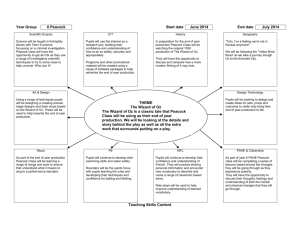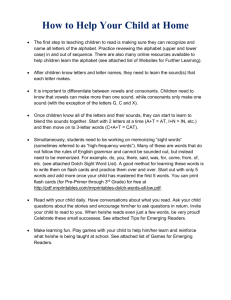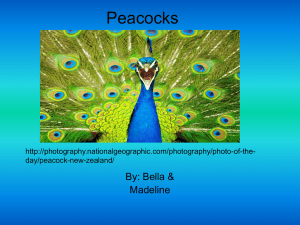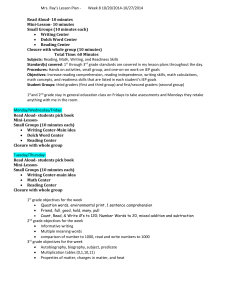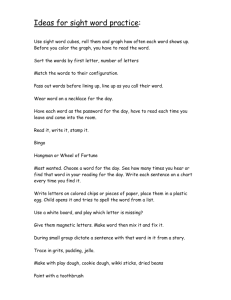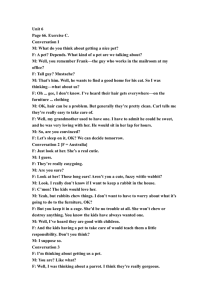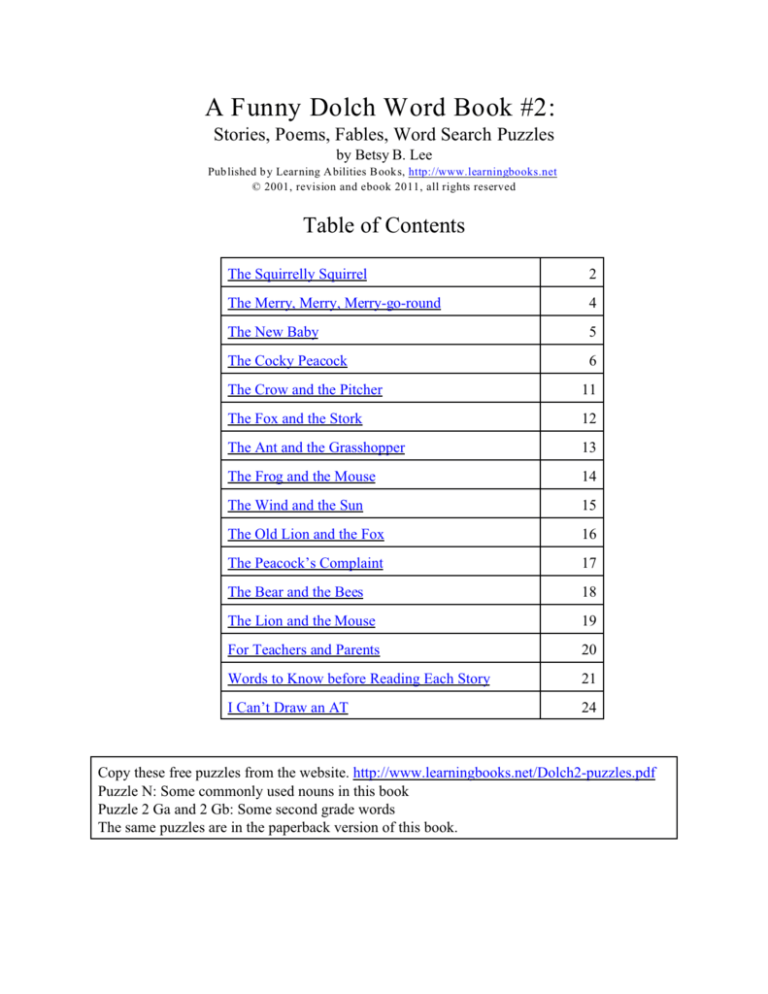
A Funny Dolch Word Book #2:
Stories, Poems, Fables, Word Search Puzzles
by Betsy B. Lee
Pub lished b y Learning Abilities Books, http://www.learningbooks.net
© 2001, revision and ebook 2011, all rights reserved
Table of Contents
The Squirrelly Squirrel
2
The Merry, Merry, Merry-go-round
4
The New Baby
5
The Cocky Peacock
6
The Crow and the Pitcher
11
The Fox and the Stork
12
The Ant and the Grasshopper
13
The Frog and the Mouse
14
The Wind and the Sun
15
The Old Lion and the Fox
16
The Peacock’s Complaint
17
The Bear and the Bees
18
The Lion and the Mouse
19
For Teachers and Parents
20
Words to Know before Reading Each Story
21
I Can’t Draw an AT
24
Copy these free puzzles from the website. http://www.learningbooks.net/Dolch2-puzzles.pdf
Puzzle N: Some commonly used nouns in this book
Puzzle 2 Ga and 2 Gb: Some second grade words
The same puzzles are in the paperback version of this book.
2
The Squirrelly Squirrel
“Go away, you squirrelly squirrel!” says Laura. “Get
off the bird feeder.”
The squirrel runs up the string which ties the bird
feeder to a limb. The squirrel sits on the limb and
watches Laura. It flicks its tail five times.
“You have nuts to eat. They are all over the ground,”
says Laura. “The seeds in the bird feeder are for the
birds.”
The squirrel looks right at her and says, “Chee, chee,
chee.” It flicks its tail many times.
“I want to hear the birds sing. I wish you would go
away. I don’t like to hear your chee, chee, chee,” says
Laura.
“Chee, chee, chee,” says the squirrel. It runs very
fast to the top of the hickory tree.
“Go!” says Laura. “I don’t want to tell you again.”
She walks into the house and sits at the table.
She looks out the window in time to see the squirrel
jump onto the bird feeder.
She pulls a chair out to the tree. She gets on the
chair, and she cuts the string. She ties it to a very little
limb. Now the bird feeder is far from the tree trunk.
It is far from the ground.
“That will work,” says Laura. She goes in the house
to watch.
3
The squirrel runs fast on the big limbs. It does not
go fast on the little limb. The little limb shakes and
shakes. The squirrel stops. The limb stops shaking. The
squirrel walks far onto the little limb. The little limb
shakes and shakes. The squirrel runs fast to the big
limb. Then, it flicks its tail five times and says, “Chee,
chee, chee!”
It goes fast around the tree trunk. It stops and
says, “Chee, chee, chee.” It jumps at the bird feeder
and falls on the green grass.
It sits under the bird feeder and says, “Chee, chee,
chee!” The squirrelly squirrel does not like this at all.
It jumps up, but the bird feeder is too far away. It
jumps again and again. It runs around the tree trunk
again and jumps. It just cannot get to the bird feeder.
The squirrel runs to find some nuts.
A red bird flies to the bird feeder. It sits and eats
seeds. Then it sings.
Laura smiles.
4
The Merry, Merry, Merry-go-round
Sue rides up and down,
And around and around
On the merry, merry,
Merry-go-round.
Her father is there
In the crowd somewhere
By the merry, merry,
Merry-go-round.
Now, she sees his face.
He watches her race
On the merry, merry,
Merry-go-round.
She rides right ahead
Of a horse that is red
On the merry, merry,
Merry-go-round.
Sue gets first place
In a very fast race
On the merry, merry,
Merry-go-round.
5
The New Baby
The new baby takes a lot of mother’s time.
She must sit with the baby and wash the baby.
I buy a toy for the baby.
Both of us play.
As the baby gets older,
We will play with many toys.
Mother sings and reads to both of us.
I like to sing and read.
I write a story for the baby.
I read my story to the baby.
After the baby goes to sleep,
Mother makes time just for me.
She reads to me,
And I read to her.
Then I make time just for her
To do other things.
I am big. I take my own bath,
And I go to sleep.
6
The Cocky Peacock
The man let the peacock out of his pen. “I like to let
you out because you need to be free,” said the man. “I
just wish you would not be a bully.”
As soon as the man went into the house, the peacock
chased a car. A girl in the car laughed. Then she said, “A
bird! We are chased by a bird!”
The man came out and called, “Come here, you cocky
peacock!”
The peacock flew to the top of a tree. He came down
after the car went away.
At night, the peacock went into his pen to eat corn.
Then the man shut the gate.
“You must stay in there because you must not chase a
car,” he said. “You don't know how to be free. Your pen
is your place for time out.”
After the peacock had been in time out for one day,
the man let him out and said, “I think you will not run
after a car now.”
As soon as the man went into the house, the peacock
chased the little dog. They ran around and around. The
peacock flew over the dog. The little dog ran under the
house.
The man came out and called, “Come here, you cocky
peacock!”
7
The peacock flew to the top of a tree.
The man called to the dog, “Come here. I will play
with you.” The dog would not come out to play.
The man put the dog's dish on the ground. The dog
would not come out to eat.
At night, the peacock went into his pen to eat corn.
Then the man shut the gate.
“You must stay in there because you must not chase
the dog or a car.” he said. “You don't know how to be
free. Your pen is your place for time out.”
The peacock turned his back to the man. He spread
his big tail like a fan, and he walked away.
The man said to the dog, “Come here! You have been
under the house all day.” The dog would not come.
The little dog and the big cat were friends. The man
put the cat's dish by the dog's dish. The cat came to
eat. The dog came out to eat by his friend.
The next day, the peacock stayed in time out. He
looked at the dog, the cat, and the horse. The big cat
sat on the fence. She jumped down and went to sleep.
The little dog played with a ball.
The horse came out of the barn. He had a mouthfull
of sweet feed. He dropped some of it on the ground. A
little bird ate the sweet feed.
After the peacock had been in time out for two days,
the man let him out and said, “I think you will not run
after the dog now. I think you will not be a bully.”
8
As soon as the man went into the house, the peacock
chased the horse. The cocky peacock’s big tail looked
like the eyes of many wild things. The horse was very
afraid. He ran and ran. The peacock flew over the horse.
The horse ran to the barn.
The peacock sat in the tree. He looked and looked at
the barn door. The horse would not come out.
The man came out and called, “Come here, you cocky
peacock! Why don't you do right!”
The peacock would not come. He was out all day.
The horse was in the barn all day. She had no green
grass to eat.
At night, the peacock went into his pen to eat corn.
Then the man shut the gate.
“You must stay in there because you must not chase
the horse. You must not chase the dog or a car,” he said.
“You don't know how to be free. Your pen is your place
for time out.”
The peacock turned his back to the man. His his big
tail feathers looked like a fan. The peacock walked away.
The dog, the horse, and the cat liked to be free.
The cat would sit on the fence, and the dog would sit
under the fence. The horse would stand at the fence
where she would eat the green grass.
The man put sweet feed in the barn for the horse to
eat. She walked out and left sweet feed along the way.
9
After the peacock had been in time out for three
days, the man let him out and said, “I think you will not
be a bully, now.”
As soon as the man went into the house, the peacock
saw the big cat sit on the fence. The peacock wanted to
sit on the fence. He pecked the big cat.
The cat jumped down on the grass. The peacock
jumped down on the grass too.
The cat was almost as big as the peacock. The cat
chased the peacock. The cat could run fast. The peacock
could not run fast. The cat got some of the peacock's
feathers before the peacock had time to fly away.
The peacock flew to the top of a tree.
The cat jumped to the top of the fence.
The man came out and called, “Come here, you cocky
peacock!”
The peacock would not come. He was out all day.
At night, the peacock went into his pen to eat corn.
Then the man shut the gate.
“You must stay in there because you must not chase
the cat. You must not chase the dog, the horse, or a
car.” he said. “You don't know how to be free. Your pen
is your place for time out.”
After the peacock had been in the pen for four days,
the man let him out and said, “I think you can be nice,
now.”
10
As soon as the man went into the house, the peacock
walked to the barn. He saw the dog, the cat, and the
horse at the fence. They did not see him.
The peacock walked to the barn door where he found
bits of sweet feed on the ground. A little bird ate some
of it. The peacock at some of it too. The sweet feed was
better than the corn which the man gave him. It was the
very best.
Then the horse saw the peacock. She could not
run to the barn because the peacock was at the door.
The three friends watched the big bird carefully.
He flew to the top of a tree. He was out all day. He
did not run after those friends.
At night, he went into his pen to eat corn. The man
shut the gate. At night, the gate was always closed to
keep out other animals like racoons.
After the peacock had been in the pen all night, the
man let him out and said, “I saw what you did. I think
you know how to be free.”
The peacock made friends with the dog, the horse,
and the cat. The horse always gave him some sweet
feed. The cat let him sit on the fence.
11
The Crow and the Pitcher
An Aesop’s Fable
Two crows were almost dead because they needed
water. They saw a pitcher which had some water in it.
They could not reach down into the pitcher to get the
water.
The first crow tried to pull the pitcher over. It was
too big for him to move it. He gave up and went away.
The second crow found a pebble and put it in the
pitcher. This made the water come up a little bit, but he
could not reach the water.
He took another pebble and put it in the pitcher.
This made the water came up some more, but he still
could not reach the water.
He did this again and again. The water came up and
up. Then it came up to the top.
He got the water.
A little work at a time can get a big job done.
12
The Fox and the Stork
An Aesop’s Fable
The fox and the stork were friends. Once, the fox
asked the stork to eat with him. The fox made soup, and
he put it in a wide bowl.
“Why don’t you eat? Don’t you like it?” he asked.
“I don’t use a bowl for eating,” said the stork.
“I do,” said the fox as he lapped the food up.
“I am treating you as I would like to be treated.”
The stork could not get the soup with her long bill.
Then she went away hungry.
The next day, the fox ate at the stork’s home. The
stork had put fish at the bottom of a tall, narrow jar.
“The fish smells very good,” said the fox, “but I
cannot pull the fish out.”
“Ah,” said the stork. “I am treating you as I would
like to be treated.”
Treat others the way they would like to be treated
if you were them.
13
The Ant and the Grasshopper
An Aesop’s Fable
One warm day, the grasshopper jumped and played.
He stopped when he saw the ants working.
“Come play with me,” called the grasshopper. “These
days are days for playing.”
“No! These days are for getting food before the
snow comes. We must use these days to work,” said one
ant.
“Look at all of those good things that we can eat
right now,” said the grasshopper. He looked at the green
grass and the big garden.
“Think about what will happen if you don’t work,” said
the ant.
“I want to think about playing,” the grasshopper said
as he played.
The ant worked with many other ants. They put food
in their nest.
The cold winds came. The snow came.
Those ants ate their food in the nest. The
grasshopper hopped all around looking for food.
It is best to do today’s work today.
Don’t wait till later.
14
The Frog and the Mouse
An Aesop’s Fable
The frog was so mad that he wanted to hurt someone.
He called to a young mouse, “Would you like to know how
to swim?”
“Swim?” asked the mouse. “I have not tried to swim
before.”
“Come on,” said the frog. The mouse let him tie his
leg to the frog’s leg. Then the frog pulled the mouse
down into the water. They went down fast.
“I cannot live down here,” said the mouse. “I need
air.”
The frog swam and swam. The poor mouse died.
The frog jumped onto the land.
Just then, a hawk flew over him. The hawk flew fast.
The frog tried to untie the mouse fast.
The hawk came faster.
The frog tried to hop away from the hawk. He could
not go very fast with the mouse tied to him.
The hawk would have missed him if the frog had not
tied the mouse to his leg.
That was the end of the frog.
When we try to hurt others, we hurt ourselves.
15
The Wind and the Sun
An Aesop’s Fable
“I am the best,” said the sun. “I am stronger
than you.”
“I am the best,” said the wind. “I am stronger.”
“We will see,” said the sun. “Look at that man. If you
can make him take off his coat, you are stronger. If I
can make him take off his coat, I am stronger.”
“All right,” said the wind.
“You may be first,” said the sun as it went behind a
cloud.
The wind blew cold and hard. The man pulled his coat
around himself closely. The wind blew him up the hills
and down the hills. The man would not take off his coat.
“I give up,” said the wind.
The sun came out from behind the cloud. It thought
about what the man wanted. The sun made the man feel
warm. He gladly took off his coat.
“You showed me a new way to be strong,” said the
wind.
When we want someone to do something,
it is best to help them be glad to do it.
16
The Old Lion and the Fox
An Aesop’s Fable
Once upon a time, a lion was too old to hunt very well
so he made a plan.
“Oh! I am so sick. Please! Come to see me, or I will
die all alone,” he called as a chicken walked by.
The chicken felt sorry for the old lion, and he walked
into the den. The lion ate the chicken.
“Oh! I am so sick. Please! Come to see me, or I will
die all alone,” he called as a duck walked by.
The duck felt sorry for the old lion, and she walked
into the den. The lion ate the duck.
A deer, a wolf, and a rabbit felt sorry for him. One
by one, they went into the den and he ate them.
“Oh! I am so sick. Please! Come to see me, or I will
die all alone,” he called as a fox walked by.
“Oh! I don’t think so,” said the fox. “Thank you for
asking, but I see many footprints going into your den. I
don't see any coming out. A sick lion should not have a
crowd in his den. It would be best for the others to
come out before I go in.”
The fox ran away fast.
To stay out of trouble,
don’t make the same mistakes others make.
17
The Peacock’s Complaint
An Aesop’s Fable
“I am coming! I am coming!” called the man as he ran
out of the house. “Where are you? I know a woman
called for help.”
He looked around, and he saw the peacock.
“Ah!” said the man. “It is just your bad singing. Your
call is like a woman calling, ‘Help! Help!’ ”
The man went into the house.
The peacock asked God, “Please! Make me sing like
the nightingale. That bird is the best.”
“I like you very much,” said God. “But the nightingale
has its call, and you have your call.”
“But I don’t like my call!” said the peacock.
“All birds are not the same. Use what you have,” said
God. “Many people like you the best. You have friends.
But the man does not make you live in a little cage so he
can hear you sing.”
“Ah!” said the peacock. “I would not like to live in a
little cage. It is best that the man does not want to
hear me sing!”
Others are not always as lucky as they seem.
We need to be thankful for what we have.
18
The Bear and the Bees
An Aesop’s Fable
A big bear found a bee hive. He put one paw in it so
he could get some good honey.
One little bee stung him on the paw.
Some bears don’t let bees make them mad. They get
some stings, but they get the honey, too.
One little bee made this big bear very mad. He hit
the bee! He hit the bee hive!
This made all of the bees very mad. Many bees came
out fast. Those bees were all around him. They stung his
head and hands.
The big bear ran fast to a river. He went under the
water to make the bees stop.
Getting mad over little things can make it worse.
19
The Lion and the Mouse
An Aesop’s Fable
A lion went to sleep under a green tree.
A little mouse found a lion asleep. The mouse had fun
running up and down on the sleeping lion.
“I am going up a big hill,” said the mouse as he ran up
the lion’s leg.
“I can slide down the hill,” said the mouse as he went
fast down the lion’s leg.
“And I can eat you up,” said the lion as he put his big
paw on the mouse.
“Please, don’t kill me! Have mercy!” said the mouse. “I
would be your friend. I would help you.”
“What!” said the lion. “A little mouse can help a big
lion?”
“Yes! Yes!” said the little mouse.
The lion laughed and let the little mouse go.
One day, the mouse saw the lion tied up with many
ropes. The men had gone off, but they would be back.
They had tied the lion’s mouth shut so he could not cut
the ropes with his big teeth. The lion’s little friend cut
the ropes with his little teeth.
We try to help someone who has helped us.
20
For Teachers and Parents
Benefits of Having No Pictures
1. One true test of independent reading is to read the word with no help from pictures or oral
cues. Some people can recognize a word on a list without being able to read it in a story. The
goal is reading comprehension in sentences and stories, not just word recognition.
2. Readers can develop creativity by creating their own mental images and making their own
illustrations.
3. Remedial use is enhanced because ages of the characters are not shown by text or pictures.
Aesop’s Fables were originally for all ages, not just for children. Some fables protest tyranny.
4. Pictures often lead to lucky guesses. Enjoy the poem, I Can’t Draw an AT.
What are Dolch words?
E. W. Dolch surveyed numerous children’s books, and he compiled lists of words. From 50%
to 75% of the words in these books are on his lists. Knowing these on sight increases fluency.
Dolch words need to be recognized instantly without depending on pictures for cues. Many of
these words cannot be sounded out, e.g. “is” sounds like “iz.”
He identified 220 words in pre-primer - third grade books. The lists show levels of frequency
in books not levels of difficulty, e.g. the word “if” on the third grade list was not used often in
first grade books. He also identified 95 of the most commonly used nouns but he did not specify
pre-primer through third grade levels. All of the Dolch sight words for the second grade list are in
this book. Dolch words from the lists for pre-primer through third grade should be mastered in
first grade for fluent reading.
The Most Effective Use of This Book
1. Help students learn the sight words in each story before showing the story.
2. Reach a level of success on each story before moving to the next one. On your copy of the
story, note problem words. Help the student practice these and have the student read the story
until it is read fluently. Each story has some of the words from previous stories plus new ones.
Work on speaking-hearing vocabulary development and concept development as appropriate.
3. Several activities for learning words are on the Learning Abilities Books site which also has
free Dolch sight word flash cards and memory strategies.
4. English is read from left to right or top to bottom. Most words are in lower case. Puzzles
with all capital letters or reversed words can be counterproductive for struggling readers. In this
book, all of the correct answers in puzzles are read from left to right or top to bottom.
Four Dolch Sight Words by the Same Author
These are on the Learning Abilities Books site http://www.learningbooks.net
A Funny Dolch Sight Word Book #1: Stories, Poems, Word Puzzles (pre-primer - 1st Gr.)
A Funny Dolch Sight Word Book #2: Stories, Poems, Fables, Word Puzzles (2nd Gr.)
A Funny Dolch Sight Word Book #3: Stories, Fables, Word Puzzles (3rd Gr.)
Albert, the Apple Eating Appaloosa Dolch Horse Stories (practice different word endings)
21
Words to Know before Reading Each Story
Note
Speaking-hearing Vocabulary: “Squirrelly” is an example of a word which might be spoken or
heard without a real understanding of the meaning. Some students might not have observed
squirrels. “The Squirrelly Squirrel” is a true story.
In these stories, care is taken to use Dolch words as often as possible instead of using more
colorful expressions. Many of the nouns are taken from the Dolch list of 95 frequently used
nouns.
Concept Development: Morals of fables might be remembered better by rephrasing the morals
without limiting them to Dolch words, e.g. “The Bear and the Bees” is a great example of “Don’t
sweat the small stuff.”
Fables often have vivid illustrations of what not to do. The morals clearly indicate a better
choice. Encourage students to think about choices and consequences.
2 The Squirrelly Squirrel
2nd Gr. Dolch Words: around, does, don’t fast, five, goes, its, many, off, pull, right, sing, sit,
tell, very, wish, work, would, your
3rd Gr. Dolch Words: cut(s), far
Dolch Nouns: squirrel, bird, string, watch(es), ground, grass, table, seed(s), top, window,
chair, tree, house
Vocabulary and/or Concept Development: Discuss “Squirrelly.”
4 The Merry, Merry, Merry-go-round
2nd Gr. Dolch Words: around, fast, first, right, very
Dolch Nouns: father, horse
Vocabulary and/or Concept Development: They can make a mental image of the red horse
racing behind her horse as she her dad is watching.
5 The New Baby
2nd Gr. Dolch Words: both, buy, many, read, sing, sit, sleep, us, wash, write
Dolch Nouns: baby, toy, mother
Vocabulary and/or Concept Development: Discuss positive instead of negative thoughts about
a new member of the family.
6 The Cocky Peacock
2nd Gr. Dolch Words: always, around, because, been, best, call, don’t, fast, found, gave,
green, made, many, right, sleep, sit, those, upon, why, would
Dolch Nouns: man, dog, cat, horse, house, night, corn, day, thing(s), door
Vocabulary and/or Concept Development: Talk about cocky behavior and bullies. The
peacock needed to think about the feelings of others. Freedom calls for responsible behavior. The
peacock was influenced by several things but it was his decision to behave differently. I’ve seen
a peacock chase a car, a dog, and a horse. He pecked the cat but the cat had the advantage when
both of them were on the ground. Did the cat hope the bird would follow him to the ground?
11 The Crow and the Pitcher
2nd Gr. Dolch Words: because, first, found, gave, made, pull
Dolch Nouns: water
Vocabulary and/or Concept Development: You might need to illustrate how the pebbles made
the water rise to the top. The moral could apply to getting schoolwork done a little at a time
instead of giving up like the first crow did.
12 The Fox and the Stork
2nd Gr. Dolch Words: made, pull, right, very, why, would
Dolch Nouns: fish, home
Vocabulary and/or Concept Development: Some versions of the moral to this fable state: "Do
unto others as you would have them do unto you." We often forget the last part of that statement:
"as you would have them do unto you," i.e. if you were in their shoes. Other versions of the
moral state: "One bad turn deserves another."
13 The Ant and the Grasshopper
2nd Gr. Dolch Words: before, cold, don’t, first, green, right, their, these, those, use, work
Dolch Nouns: day
Vocabulary and/or Concept Development: Work and save so you will have what you need.
Plan ahead. Be responsible and ready for hard times.
14 The Frog and the Mouse
2nd Gr. Dolch Words: before, call, fast, pull, very, would
Dolch Nouns: leg, water
Vocabulary and/or Concept Development: When we are angry, we might not stop to think
about making good choices. An angry choice can hurt us as much or more than it hurts others.
15 The Wind and the Sun
2nd Gr. Dolch Words: around, best, cold, first, made, of, off, or, pull, right, us, which,
would
Dolch Nouns: sun, wind, coat
Vocabulary and/or Concept Development: Kindness gets better results than meanness. You
catch more flies with honey than with vinegar.
16 The Old Lion and the Fox
2nd Gr. Dolch Words: best, call, don’t, fast, made, many, or, upon, which, would
Dolch Nouns: chicken, duck, rabbit
Vocabulary and/or Concept Development: Although a fox is small, he is often smart enough
to keep hunters from catching him.
17 The Peacock's Complaint
2nd Gr. Dolch Words: always, around, best, call, does, don’t, many, sing, use, very, would,
your
Vocabulary and/or Concept Development: They might know the word, complain, but not the
word, complaint. This can be an easy opportunity to expand vocabulary. Many versions of this
fable refer to the Greek god, Juno. It is misleading if readers think of juno.com instead of Juno.
18 The Bear and the Bees
2nd Gr. Dolch Words: around, fast, found, made, many
Dolch Nouns: bear, hand(s), head
Vocabulary and/or Concept Development: "Don't sweat the small stuff." Angry actions can
make things worse. There are important differences in angry thoughts and angry actions.
19 The Lion and the Mouse
2nd Gr. Dolch Words: fast, found, green, many, off, sleep, would
Dolch Nouns: hill
Vocabulary and/or Concept Development: Little friends can be great friends.
Free Materials on the Website http://www.learningbooks.net
Dolch Book Excerpts and Notes for Teachers
Fables with Dolch Sight Words: Lesson Plan and Worksheets to Write a Fable
Flash Cards of Dolch Sight Words
Lesson Plans for Memory Strategies, e.g Learning Left from Right
Lists of all Dolch Words
Puzzles with Lower Case Letters and No Reversed Words
Reading Readiness Includes Similarities-differences Instruction with Dolch Sight Words.
Recognition and Mental Images with lessons and the Poem: "I Can't Draw an AT"
Sentences and Stories using Dolch Nouns and a Worksheet
Exercises for Writing Words, Sentences, and Books
24
I Can’t Draw an AT
© Betsy B. Lee, 2003
http://www.learningbooks.net
Can you draw an AT?
I can draw a hat.
But Dolch words should be known on sight
If they will be read just right.
I can draw a cat.
I just can't draw an at.
If sight word mastery is the goal,
Pictures are not the things to behold.
Can you draw meanings of here and there?
Dolch words like these are seen everywhere.
Pictures can help children visualize.
Dependance on pictures can close their eyes.
It makes reading much more fun
To learn these words in grade one.
They need to learn to read the text
Or the readers could be vexed!
The words on lists for grades two and three
Aren't seen in grade one as frequently.
Draw a picture with many a word?
Oh, I don't think that's absurd.
They still are found in first grade.
Knowing these words gives reading much aid.
It helps the mind to live and grow
Like making a personal movie show.
An illustration can give a clue
For guessing a word. That's certainly true.
When words don't sound the way they look,
Should teachers use flash cards or a book?
Making a guess can bring a smile
Or cause a miss by a mile.
Flash cards are fine from time to time.
Dolch books are fun, like rhythm and rhyme.
Decoding words is another way
To comprehend what words say.
When all is said and all is done,
I'll take you back where I've begun.
I can't draw an AT, a WAS, or a TOO.
Can you?
Return to Benefits of Having No Pictures

